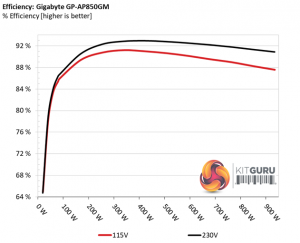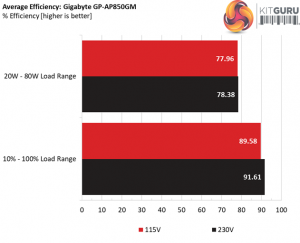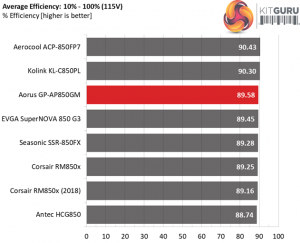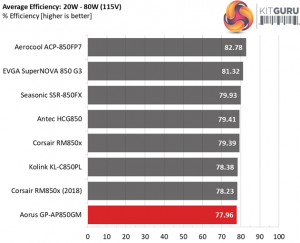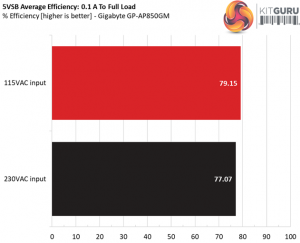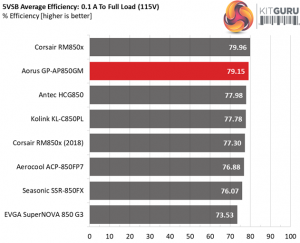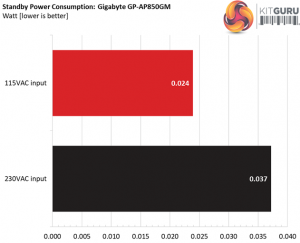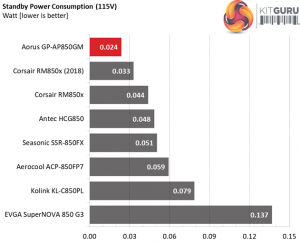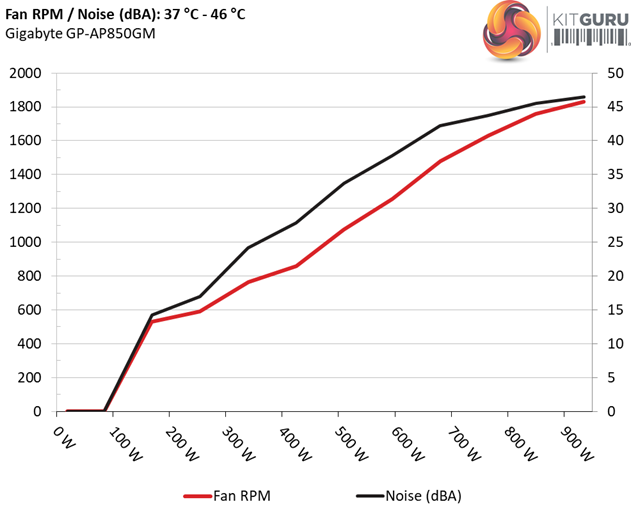Efficiency
Our efficiency testing procedure is detailed here.
Using results from the previous page, we plotted a chart showing the GP-AP850GM’s efficiency at low loads, and loads from 10 to 110 percent of its maximum-rated capacity.
The Aorus unit naturally takes the lead from the Gold competition, however it stays behind two Platinum models with similar capacity. With light loads its efficiency is not high.
Efficiency At Low Loads
In the following tests, we measure the GP-AP850GM's efficiency at loads significantly lower than 10 percent of its maximum capacity (the lowest load the 80 PLUS standard measures). The loads we dial are 20, 40, 60, and 80W. This is important for representing when a PC is idle, with power-saving features turned on.
| Test # | 12V | 5V | 3.3V | 5VSB | DC/AC (Watts) | Efficiency | Fan Speed (RPM) | PSU Noise (dB[A]) | PF/AC Volts |
| 1 | 1.172A | 0.492A | 0.469A | 0.194A | 19.470 | 64.937% | 0 | <6.0 | 0.796 |
| 12.266V | 5.086V | 3.400V | 5.143V | 29.983 | 115.11V | ||||
| 2 | 2.414A | 0.984A | 0.969A | 0.390A | 39.903 | 78.102% | 0 | <6.0 | 0.905 |
| 12.264V | 5.084V | 3.398V | 5.136V | 51.091 | 115.11V | ||||
| 3 | 3.593A | 1.477A | 1.440A | 5.128A | 59.481 | 83.344% | 0 | <6.0 | 0.948 |
| 12.268V | 5.084V | 3.398V | 5.128V | 71.368 | 115.12V | ||||
| 4 | 4.833A | 1.968A | 1.942A | 0.781A | 79.883 | 85.471% | 0 | <6.0 | 0.960 |
| 12.266V | 5.083V | 3.398V | 5.120V | 93.462 | 115.12V |
The fan is not engaged at all under light loads, keeping the unit's output noise at minimal levels. We are not left satisfied by the registered efficiency levels though. We would like to see close to 70% with 20W load and above 80% with 40W.
5VSB Efficiency
The ATX specification (revision 1.4), along with CEC, ErP Lot 3 2014 and ErP Lot 6 2010/2013, states that the 5VSB standby supply efficiency should be as high as possible, recommending 75 percent or higher with 550mA, 1A, and 1.5A of load.
The supply should also achieve higher than 75% efficiency at 5VSB under full load, or with 3A if its max current output on this rail is higher than 3A.
We take six measurements: one each at 100, 250, 550, 1000, and 1500mA, and one with the full load the 5VSB rail can handle.
| Test # | 5VSB | DC/AC (Watts) |
Efficiency | PF/AC Volts |
| 1 | 0.100A | 0.515 | 78.626% | 0.062 |
| 5.148V | 0.655 | 115.10V | ||
| 2 | 0.250A | 1.286 | 79.678% | 0.143 |
| 5.144V | 1.614 | 115.10V | ||
| 3 | 0.550A | 2.824 | 79.842% | 0.250 |
| 5.135V | 3.537 | 115.10V | ||
| 4 | 1.000A | 5.122 | 80.156% | 0.331 |
| 5.122V | 6.390 | 115.10V | ||
| 5 | 1.500A | 7.661 | 79.282% | 0.377 |
| 5.107V | 9.663 | 115.10V | ||
| 6 | 3.000A | 15.190 | 78.118% | 0.437 |
| 5.063V | 19.445 | 115.10V |
The 5VSB rail is highly efficient and stacks up pretty well against similar capacity units.
Power Consumption In Idle And Standby
In the table below, you’ll find the power consumption and voltage values of all rails (except -12V) when the PSU is idle (powered on, but without any load on its rails), and the power consumption when the unit is in standby mode (without any load, at 5VSB).
| Mode | 12V | 5V | 3.3V | 5VSB | Watts | PF/AC Volts |
| Idle | 12.250V | 5.079V | 3.388V | 5.149V | 7.823 | 0.414 |
| 115.1V | ||||||
| Standby | 0.024 | 0.002 | ||||
| 115.1V | ||||||
The vampire power levels of this platform are really low. Cudos to MEIC for this.
Fan RPM, Delta Temperature, And Output Noise
Our mixed noise testing is described in detail here.
The first chart below illustrates the cooling fan's speed (in RPM), and the delta between input and output temperature. The results were obtained at 37°C (98.6°F) to 46°C (114.8°F) ambient temperature.
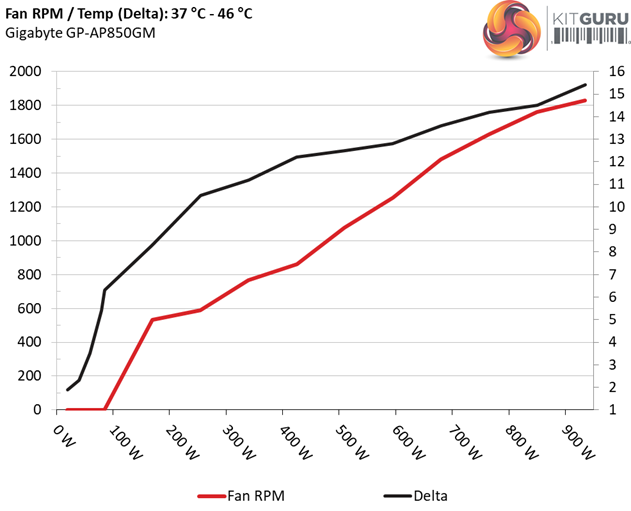
The next chart shows the cooling fan's speed (again, in RPM) and output noise. We measure acoustics from one meter away, inside a hemi-anechoic chamber. Background noise inside the chamber is below 6 dB(A) during testing (it's actually much lower, but our sound meter’s microphone hits its floor), and the results are obtained with the PSU operating at 37°C (98.6°F) to 46°C (114.8°F) ambient temperature.
The following graph illustrates the fan's output noise over the PSU's operating range. The same conditions of the above graph apply to our measurements, though the ambient temperature is between 30°C (86°F) to 32°C (89.6°F).
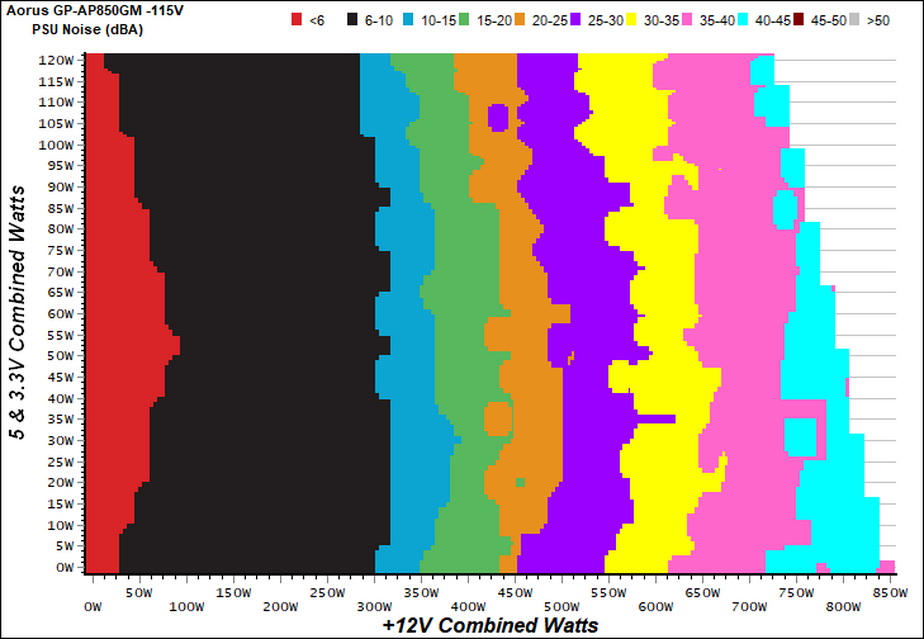
The passive operation doesn't last long, but the fan spins at very low speeds up to 300W load (at +12V). It takes more than 550W load at +12V for the fan to enter the 30-35 dB(A) noise while the 40 dB(A) mark is passed with >710W load.
 KitGuru KitGuru.net – Tech News | Hardware News | Hardware Reviews | IOS | Mobile | Gaming | Graphics Cards
KitGuru KitGuru.net – Tech News | Hardware News | Hardware Reviews | IOS | Mobile | Gaming | Graphics Cards


